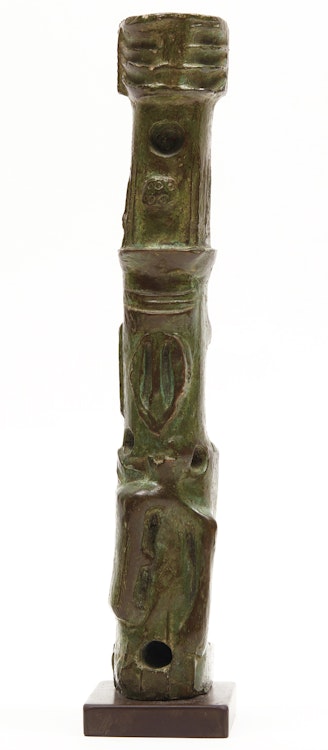Upright Motive No. 4 (LH 381) by Henry Moore





Henry Moore
Upright Motive No. 4 (LH 381)
green patinated bronze
Foundry Fiorini Limited, London, United Kingdom; from an edition of 9
12.5 x 2.25 x 3 in ( 31.8 x 5.7 x 7.6 cm ) ( overall, including base )
Auction Estimate: $10,000.00 - $15,000.00
Price Realized: $11,400.00
William Enterprises Inc., Beverly Hills, no. 1582
Private Collection
Anita Feldman, "O’Keefe and Moore", San Diego, 2023, page 191
The association of Moore’s sculpture with Britain’s landscape would thus become
a dominant motif within the critical positioning of his work. These two bronzes, measuring less than twelve inches each, are representations on a smaller scale of Moore’s series of large "Upright Motives", reminiscent of North American totem poles and works from New Ireland in Papua New Guinea. Their verticality and abstract features ultimately reveal Moore’s return to some of the concerns of his pre-war Surrealist phase. His vocabulary of organic forms, whether reclining or upright, leads to a universal reading of his work, providing an image of humankind that is both contemporary and timeless.
Share this item with your friends
Henry Moore
(1898 - 1986)
Henry Moore is one of Britain’s most significant artists of the twentieth century as well as a highly influential figure in modern sculpture. Born in a small coal-mining town of Castleford, Yorkshire in the north of England, he was the seventh out of a family of eight children. Despite an early ambition to be a sculptor, Moore followed his father’s wish to become a schoolteacher. His studies got cut short due to World War I, when he enlisted in the British Army and was sent to France. After suffering from the effects of gas shells, he returned to England and in 1919 was given a rehabilitation grant, which he used to attend the Leeds School of Art. Moore studied drawing and sculpture during his two years of studies. He then passed the sculpture examination and was awarded a Royal Exhibition scholarship to study at the Royal College of Art in London. In September 1921 he moved to London and began three years of advanced study in sculpture; he took his diploma at the Royal College after two years and spent a third year doing postgraduate work. What was most significant about Moore’s stay in London was not his schooling but his exposure to the important works of art in the city’s major museums. He was particularly inspired by the collection of Egyptian, Etruscan and Classical sculpture at the British Museum.
Upon graduating from the Royal College in 1924, Moore was appointed a part-time instructor in sculpture there for a seven-year term. He began working in 1926 on depictions of reclining women, which would become his most famous and recognizable subject. He was also carving a variety of subjects in stone, including half-length female figures, mother-and-child groups, and masks and heads. In the early 1930s, Moore’s circle of artistic friends were fascinated by abstract art, though it was considered controversial to critics and the general public at the time. In his own work from 1931 onward, Moore moved tentatively away from the human figure to experiment with abstract shapes and a combination of the two themes. In 1931 he had the first of many one-man exhibitions in the Leicester Galleries in London. His work aroused violent criticism in the press and made Moore a notorious figure. When his contract at the Royal College expired in 1932, he left to start a sculpture department at the Chelsea School of Art, also in London.
At the outbreak of the Second World War, Moore left London for a more rural life in Hertfordshire. Due to a shortage of materials in the early years of the war forced Moore to concentrate on small sculptures and drawing.
Moore cemented his international reputation in 1946, following a major retrospective exhibition held at the Museum of Modern Art in New York City. This year also marked the artist’s first visit to the United States. Moore’s reputation as an outstanding sculptor was further established when he won the sculpture prize at the 1948 Venice Biennale.
As Moore got older, he became less concerned with his public role as a modern sculptor and more inclined to pursue his private interests. He also accepted many commissions for public art installations during the 1960s. In 1977 he established the Henry Moore Foundation to encourage wider enjoyment and opportunities in the arts. In addition, Moore became a prolific printmaker, executing hundreds of etchings and lithographs from the late 1960s up until his death in 1986.


